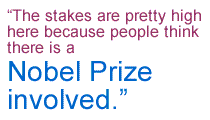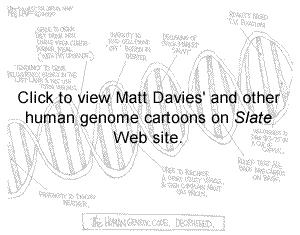
Private Company Makes Waves in Genomic Research
Craig Venter, a former NIH researcher, is the founder of Celera. The Maryland company's motto is "Discovery Can't Wait."
Venter pioneered a radical alternative to the consortium's "clone-by-clone" sequencing technique known as "whole genome shotgun cloning." Combined with massive technology and reliance on existing consortium data, Venter employed the shotgun technique to counter the consortium's head start—and trigger a war of words over whose method was faster, cheaper and more accurate, whose work was more derivative and whose publication policies best served science.
Numerous pot shots later—and after the consortium hit the gas to match Celera—the two sides agreed to jointly announce completion of separate draft versions of the human genome in June 2000. Likewise, they jointly published articles describing their findings last February—with the consortium's version appearing in Nature and Celera's in Science.

Each party claimed superior, if not totally dissimilar, results. In neither case, however, is their version of the genome complete. Both parties still must plug significant gaps—stretches of DNA where the chemical sequence that comprises the genome remains uncharted.
For UW Professor Philip Green, those patches of Swiss cheese in the consortium's sequence are one of several troubling consequences of Celera's entry into the genome derby.
Had it been up to Green, the Human Genome Project would have skipped publishing a draft sequence and stuck by its original plan of waiting until it could publish a "clean final sequence"—a much more efficient approach, he says.
"Unfortunately, the reason they didn't do that was the competition with Celera," says Green.
Recently elected to the National Academy of Sciences, Green is a professor of molecular biotechnology and adjunct professor of computer science, disciplines that intersect at precisely the point where exploration of the human genome begins.
At its core, genetics is all about biology. But without computers, scientists couldn't begin to juggle the billions of variables that must be sifted and sorted in search of the minute chemical clues that disclose distinct genes.

Journal News cartoonist Matt Davies takes a lighter look at human genome research. Click to view cartoon on Slate Web site.
That's where hybrid scientists such as Green shine. Two software programs he created called Phred and Phrap played a critical role in analyzing raw DNA samples at Human Genome Project labs around the world.
Over the years, the University has been creating curriculum and programs designed to produce more scientists like Green—people who are as comfortable at a microscope as they are at a computer screen.
The fact that the UW Genome Center is one of a relative handful of university-based participants in the Human Genome Project testifies to its status as a hub of computational biology and genetic research.
"The University has a very good collection of faculty who work in the general area of applying computational methods to biology," says Green, whose position is funded by the Howard Hughes Medical Institute. "It might well be the best in the country.
"Other places may be farther ahead in terms of setting up graduate programs in those areas, but the University of Washington is one of the leaders in that respect as well."
- Filling the Holes in Draft Genome
- UW Focus is on Technology Development
- Sidebar: Biological Revolution or Misguided Priority?
- Return to September 2001 Table of Contents